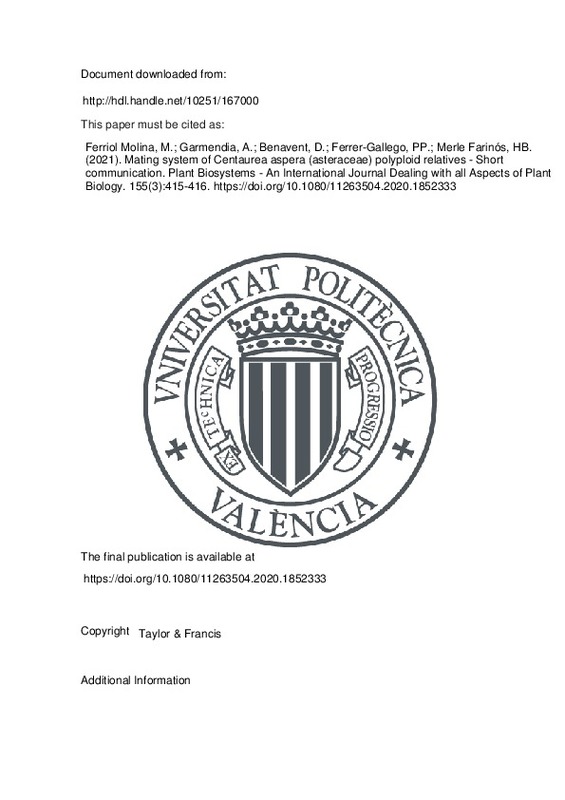JavaScript is disabled for your browser. Some features of this site may not work without it.
Buscar en RiuNet
Listar
Mi cuenta
Estadísticas
Ayuda RiuNet
Admin. UPV
Mating system of Centaurea aspera (asteraceae) polyploid relatives - Short communication
Mostrar el registro sencillo del ítem
Ficheros en el ítem
| dc.contributor.author | Ferriol Molina, María
|
es_ES |
| dc.contributor.author | Garmendia, Alfonso
|
es_ES |
| dc.contributor.author | Benavent, David
|
es_ES |
| dc.contributor.author | Ferrer-Gallego, P. Pablo
|
es_ES |
| dc.contributor.author | Merle Farinós, Hugo Basilio
|
es_ES |
| dc.date.accessioned | 2021-06-01T03:31:53Z | |
| dc.date.available | 2021-06-01T03:31:53Z | |
| dc.date.issued | 2021-05-04 | es_ES |
| dc.identifier.issn | 1126-3504 | es_ES |
| dc.identifier.uri | http://hdl.handle.net/10251/167000 | |
| dc.description.abstract | [EN] Centaurea aspera polyploid complex represents a comprehensive model. The aim of this short communication was to study the mating system of the three main species. The results showed that allotetraploid C. seridis was self-compatible (SC), while autotetraploid C. gentilii was self-incompatible (SI) as the diploid parental C. aspera (SI). | es_ES |
| dc.description.sponsorship | This work was supported by Generalitat Valenciana through AICO/2019/227 project. | es_ES |
| dc.language | Inglés | es_ES |
| dc.publisher | Taylor & Francis | es_ES |
| dc.relation.ispartof | Plant Biosystems - An International Journal Dealing with all Aspects of Plant Biology | es_ES |
| dc.rights | Reconocimiento - No comercial (by-nc) | es_ES |
| dc.subject | Compositae | es_ES |
| dc.subject | Centaurea aspera | es_ES |
| dc.subject | Centaurea seridis | es_ES |
| dc.subject | Centaurea gentilii | es_ES |
| dc.subject | Allotetraploid | es_ES |
| dc.subject | Autotetraploid | es_ES |
| dc.subject | Self-incompatible | es_ES |
| dc.subject | Self-compatible | es_ES |
| dc.subject.classification | BOTANICA | es_ES |
| dc.title | Mating system of Centaurea aspera (asteraceae) polyploid relatives - Short communication | es_ES |
| dc.type | Artículo | es_ES |
| dc.identifier.doi | 10.1080/11263504.2020.1852333 | es_ES |
| dc.relation.projectID | info:eu-repo/grantAgreement/GVA//AICO%2F2019%2F227/ | es_ES |
| dc.rights.accessRights | Abierto | es_ES |
| dc.contributor.affiliation | Universitat Politècnica de València. Departamento de Ecosistemas Agroforestales - Departament d'Ecosistemes Agroforestals | es_ES |
| dc.description.bibliographicCitation | Ferriol Molina, M.; Garmendia, A.; Benavent, D.; Ferrer-Gallego, PP.; Merle Farinós, HB. (2021). Mating system of Centaurea aspera (asteraceae) polyploid relatives - Short communication. Plant Biosystems - An International Journal Dealing with all Aspects of Plant Biology. 155(3):415-416. https://doi.org/10.1080/11263504.2020.1852333 | es_ES |
| dc.description.accrualMethod | S | es_ES |
| dc.relation.publisherversion | https://doi.org/10.1080/11263504.2020.1852333 | es_ES |
| dc.description.upvformatpinicio | 415 | es_ES |
| dc.description.upvformatpfin | 416 | es_ES |
| dc.type.version | info:eu-repo/semantics/publishedVersion | es_ES |
| dc.description.volume | 155 | es_ES |
| dc.description.issue | 3 | es_ES |
| dc.relation.pasarela | S\422984 | es_ES |
| dc.contributor.funder | Generalitat Valenciana | es_ES |
| dc.description.references | Bellanger, S., Guillemin, J.-P., & Darmency, H. (2014). Pseudo-self-compatibility in Centaurea cyanus L. Flora - Morphology, Distribution, Functional Ecology of Plants, 209(7), 325-331. doi:10.1016/j.flora.2014.04.002 | es_ES |
| dc.description.references | Ferriol, M., Garmendia, A., Gonzalez, A., & Merle, H. (2015). Allogamy-Autogamy Switch Enhance Assortative Mating in the Allotetraploid Centaurea seridis L. Coexisting with the Diploid Centaurea aspera L. and Triggers the Asymmetrical Formation of Triploid Hybrids. PLOS ONE, 10(10), e0140465. doi:10.1371/journal.pone.0140465 | es_ES |
| dc.description.references | Ferriol, M., Garmendia, A., Ruiz, J. J., Merle, H., & Boira, H. (2012). Morphological and molecular analysis of natural hybrids between the diploidCentaurea asperaL. and the tetraploidC. seridisL. (Compositae). Plant Biosystems - An International Journal Dealing with all Aspects of Plant Biology, 146(sup1), 86-100. doi:10.1080/11263504.2012.727878 | es_ES |
| dc.description.references | Ferriol, M., Merle, H., & Garmendia, A. (2014). Microsatellite evidence for low genetic diversity and reproductive isolation in tetraploidCentaurea seridis(Asteraceae) coexisting with diploidCentaurea asperaand triploid hybrids in contact zones. Botanical Journal of the Linnean Society, 176(1), 82-98. doi:10.1111/boj.12194 | es_ES |
| dc.description.references | Garmendia, A., Ferriol, M., Benavent, D., Ferrer-Gallego, P. P., & Merle, H. (2020). Intra- and Inter-Specific Crosses among Centaurea aspera L. (Asteraceae) Polyploid Relatives—Influences on Distribution and Polyploid Establishment. Plants, 9(9), 1142. doi:10.3390/plants9091142 | es_ES |
| dc.description.references | Garmendia, A., Ferriol, M., Juarez, J., Zając, A., Kałużny, K., & Merle, H. (2015). A rare case of a natural contact zone in Morocco between an autopolyploid and an allopolyploid ofCentaurea asperawith sterile tetraploid hybrids. Plant Biology, 17(3), 746-757. doi:10.1111/plb.12284 | es_ES |
| dc.description.references | Jiao, Y., Wickett, N. J., Ayyampalayam, S., Chanderbali, A. S., Landherr, L., Ralph, P. E., … dePamphilis, C. W. (2011). Ancestral polyploidy in seed plants and angiosperms. Nature, 473(7345), 97-100. doi:10.1038/nature09916 | es_ES |
| dc.description.references | Levin, D. A. (2019). Plant speciation in the age of climate change. Annals of Botany, 124(5), 769-775. doi:10.1093/aob/mcz108 | es_ES |
| dc.description.references | Soltis, D. E., Albert, V. A., Leebens-Mack, J., Bell, C. D., Paterson, A. H., Zheng, C., … Soltis, P. S. (2009). Polyploidy and angiosperm diversification. American Journal of Botany, 96(1), 336-348. doi:10.3732/ajb.0800079 | es_ES |







![[Cerrado]](/themes/UPV/images/candado.png)

